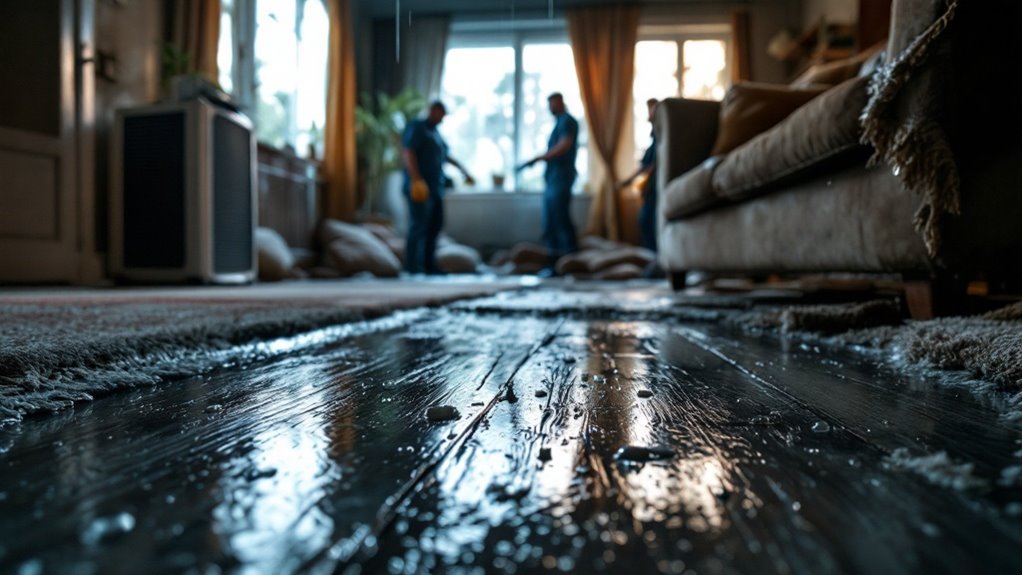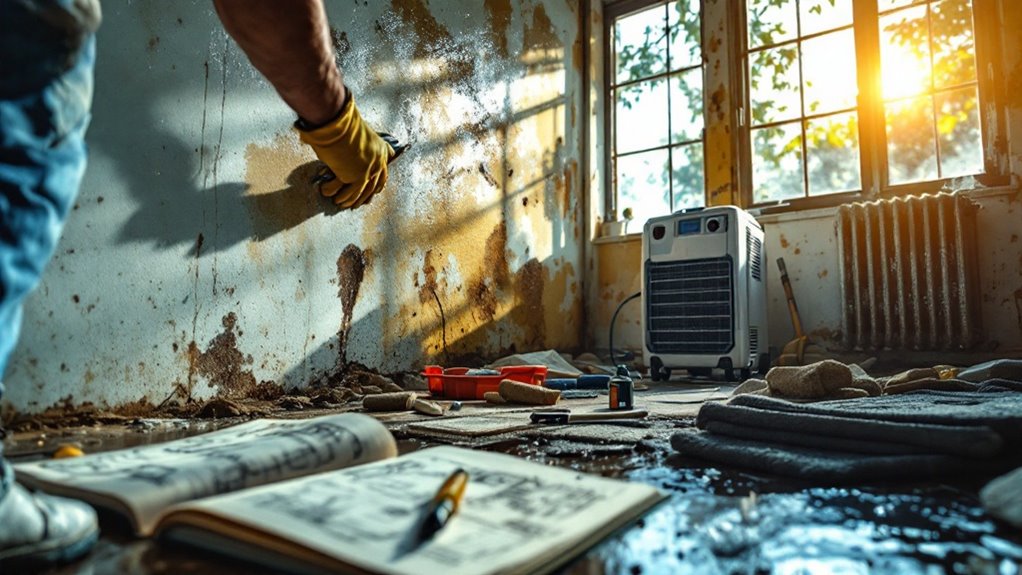When faced with an emergency water damage situation, your first instinct might be panic. Nevertheless, staying calm is crucial. You’ll need to assess the situation and guarantee everyone’s safety before taking further steps. What happens next can greatly impact the outcome of the damage. Understanding the key actions to take in the first 24 hours can make all the difference in your recovery process. Let’s investigate these critical steps and how you can effectively navigate this challenging time.
Key Takeaways
- Ensure safety by checking for hazards like live wires and shutting off electricity in affected areas.
- Contact professional help immediately for significant flooding or structural damage to ensure swift restoration.
- Document all damage thoroughly with photos, descriptions, and inventory of affected items for insurance purposes.
- Start water extraction promptly using wet/dry vacuums or pumps to prevent mold growth and further damage.
- Improve air circulation with fans and dehumidifiers while monitoring humidity levels for complete drying within 24 to 48 hours.
Assessing the Situation and Ensuring Safety

When you face water damage, the first step is evaluating the situation to confirm everyone’s safety. Check for any hazards, like live wires or slippery floors. If there’s standing water, avoid walking through it, as it may cause electrical shocks. You’ll want to shut off the electricity to affected areas and wear protective gear, such as boots and gloves, to minimize risk. Assess the extent of the water damage, noting areas that are severely affected. Open windows and doors for ventilation, but only if it’s safe to do so. Remember, your safety is the top priority. Once you’ve verified that everyone is out of harm’s way, you’ll be ready to tackle the next steps in addressing the water damage effectively. Additionally, contacting a professional water damage restoration service can ensure swift restoration and proper mitigation of the situation.
Contacting Professional Help
In some cases, contacting professional help is essential to effectively manage water damage. If the situation involves extensive flooding, sewage backup, or significant structural damage, it’s best to call in the experts. They have specialized equipment and experience to handle difficult scenarios safely and efficiently.
When you reach out, provide as much detail as possible about the situation, including the source of the water, the affected areas, and any immediate risks. This information helps professionals prepare for the job ahead. Additionally, a certified team like Flood Medics can ensure a thorough water damage restoration process to minimize long-term effects on your property.
Documenting the Damage

After contacting professionals, the next step involves documenting the damage. This vital task helps you communicate with your insurance company and guarantees you receive the support you need. Here’s how to effectively document the damage:
- Take Photos: Capture clear images of all affected areas and items.
- Make Notes: Write down specific details, including dates and descriptions of the damage.
- List Damaged Items: Create an inventory of items that are ruined or need repair, including their value.
- Gather Receipts: Collect any relevant purchase receipts or warranties for damaged items. Additionally, it’s important to have comprehensive reports prepared that detail the damage and restoration process, as this can aid in your insurance claims.
Water Extraction and Drying Process
Once you’ve documented the damage, it’s crucial to begin the water extraction and drying process promptly to prevent further issues like mold growth. Start by using a wet/dry vacuum or pump to remove standing water. If the area is large, consider calling in professionals equipped with specialized equipment. Once you’ve extracted the water, focus on drying out the affected surfaces. Open windows and doors to improve air circulation, and use fans and dehumidifiers to speed up the drying process. Keep in mind that materials like carpet and drywall can absorb moisture, so check them thoroughly. Regularly monitor humidity levels to guarantee everything dries completely within 24 to 48 hours, reducing the risk of long-term damage.
Preventing Future Water Damage

To effectively prevent future water damage, you should regularly inspect your property for potential vulnerabilities. Taking proactive steps can save you from costly repairs and emotional stress later on. Here are four key areas to focus on:
- Check Gutters and Downspouts: Make sure they’re free of debris to direct water away from your foundation.
- Inspect Pipes and Fixtures: Look for leaks or corrosion that could lead to significant water issues.
- Seal Windows and Doors: Proper sealing prevents water from seeping in during heavy rains.
- Maintain Your Roof: Regularly examine for missing shingles or damage that can cause leaks.
Conclusion
In those vital first 24 hours, your quick actions can make all the difference. As you navigate the chaos, remember that every moment counts—just like when you found that forgotten photo in the flood, a bittersweet reminder of what’s at stake. By prioritizing safety, reaching out for help, and starting the restoration process, you’re taking a stand against the damage. You’re not just saving your home; you’re preserving the memories that make it yours.
